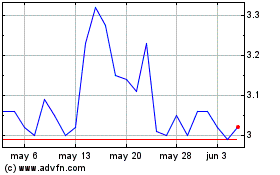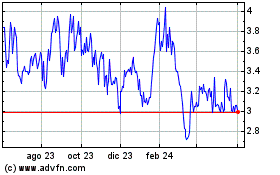Ovid Therapeutics Inc. (NASDAQ: OVID), a biopharmaceutical company
dedicated to improving the lives of people affected by rare
epilepsies and brain conditions presented the results of a
head-to-head animal study evaluating whether OV329 could be found
to accumulate in mouse retinas and brains, as has been previously
shown to occur with vigabatrin (VGB) the only FDA-approved
GABA-aminotransferase (GABA-AT) inhibitor.
The findings, which were presented via a poster
at the Epilepsy Pipeline Conference, found that OV329 cleared and
remained undetectable in the retinas, eyes, and brains of mice
after 48 hours of continuous exposure via a sub-cutaneous osmotic
pump, suggesting a lack of accumulation. In contrast, ocular
accumulation of VGB was confirmed within this period. Full results
from the head-to-head animal study will be presented at the 2024
American Epilepsy Society conference in December.
These results replicate previously published
findings that indicate VGB preferentially and rapidly accumulates
within mouse tissue and plasma, including retina, visual cortex,
and brain at subtherapeutic doses (70 mg/kg).1,2 In contrast, a
therapeutic dose of OV329 in animals (5 mg/kg) did not show signs
of ocular accumulation in the same study design. These results
complement previously presented studies which showed that
therapeutic doses of OV329 (3 mg/kg) did not result in retinal
tissue pathology at 45 days in Sprague Dawley rats, an animal model
that investigates structural and functional ocular toxicity.3 In
contrast, VGB did show retinal cell degradation at the therapeutic
dose in animals of 300 mg/kg at 45 days.
“Today’s findings suggest a compelling and
potentially differentiated profile for OV329. A combination of
attributes potentially enables OV329 to deliver an anti-convulsant
effect at lower, safer, and non-sedative doses without the same
ocular changes seen with vigabatrin,” stated Zhong Zhong, Ph.D. and
Chief Scientific Officer of Ovid Therapeutics. “Specifically,
OV329’s potency, tissue-clearance, mechanism of inhibition,
pharmacokinetic and pharmacodynamic profile suggest it is highly
efficient at binding to, and inhibiting the GABA-AT enzyme, and
then, rapidly clearing the tissue. We believe this unique
combination of drug characteristics may have application in a
variety of conditions characterized by hyperexcitation,” he
added.
STUDY METHODS AND RESULTS
At the Epilepsy Pipeline Conference, Ovid
presented results from a preclinical head-to-head study intended to
evaluate the tissue distribution of OV329 and VGB following
continuous infusion via a subcutaneous osmotic pump in mice for two
days. This study replicates and builds upon published research
examining how VGB preferentially accumulates in the retina, eye,
and visual cortex.1,2 The presented study tested OV329 at 5
mg/kg/day, compared to 80 mg/kg/day of VGB. Notably, the dose
studied for OV329 led to exposures above those expected to be
reached in humans, while VGB was tested at the established
therapeutic exposure level in humans.
- OV329 was not observed to
accumulate in the retina, eye, or brain. The
concentrations of OV329 in target tissues were below the lower
limit of quantification, or undetectable, indicating that OV329
clears and does not accumulate in the retina, eye, or brain. It is
thought that OV329’s short-half-life of 1.5 hours, quick tissue
elimination properties, and prolonged pharmacodynamic effect may
reduce the risk of ocular accumulation to occur.
- VGB has been shown to
accumulate in the eye at sub-therapeutic doses in animals and was
associated with ocular toxicity at therapeutic doses in
humans. Previous animal studies have demonstrated VGB’s
tendency to accumulate preferentially in the retina, eye, visual
cortex and brain with significantly higher retina/plasma ratios
observed (6.1 ± 0.29).1 VGB also demonstrated a higher preference
of the biological active S- (+) enantiomer to accumulate in tissues
suggesting the potential for more prominent off target
effects.4
OV329 PHASE 1 TRIAL
Ovid anticipates the completion of a Phase 1
single ascending dose (SAD) and multiple ascending dose (MAD) study
of OV329 in healthy volunteers in late 2024. This safety and
tolerability study is additionally applying magnetic resonance
spectrometry and transcranial magnetic stimulation, respectively,
as biomarkers of target engagement and potential clinical
effect.
The poster presented at the Epilepsy Pipeline
Conference can be found under the Posters and Publications section
of Ovid’s website at investors.ovidrx.com
ABOUT OV329
OV329 is a next-generation anti-seizure medicine being developed
for the potential treatment of rare and treatment-resistant forms
of epilepsy and seizures, such as seizures associated with tuberous
sclerosis complex, infantile spasms and conditions with focal onset
seizures. OV329 inhibits GABA-AT, which is an enzyme in the brain
that catabolizes GABA and thereby increases endogenous levels of
GABA, the brain’s inhibitory neurotransmitter. By increasing GABA,
OV329 is thought to reduce neuronal hyperexcitability and suppress
seizures.
OV329 was rationally designed to improve upon
and potentially supplant VGB, the only FDA-approved GABA-AT
inhibitor. VGB is an approved anti-convulsant for the treatment of
infantile spasms and refractory complex partial seizures. Use of
VGB has been limited by its Black Box warning for permanent
bilateral peripheral visual field constriction, a form of
irreversible blindness that occurs in some patients taking the
drug. Prior studies have shown OV329 to be 200-to-1,000-fold more
potent than VGB. OV329 has been shown to possess favorable tissue
clearance characteristics, while delivering prolonged PD effect
through both phasic (synaptic) and tonic (extrasynaptically)
inhibition, thereby strengthening inhibitory neurotransmission in
the neuronal milieu.
About Ovid Therapeutics
Ovid Therapeutics Inc. is a New York-based
biopharmaceutical company that is dedicated to improving the lives
of people affected by rare epilepsies and brain conditions with
seizure symptoms. Ovid is advancing a pipeline of novel, targeted
small molecule candidates that modulate the intrinsic and extrinsic
factors involved in neuronal hyperexcitability causative of
seizures and other neurological symptoms. Ovid is developing:
OV888/GV101 capsule, a potent and highly selective rho-associated
coiled-coil containing protein kinase 2 (ROCK2) inhibitor, for the
potential treatment of cerebral cavernous malformations and other
rare central nervous system diseases; OV329, a GABA-AT inhibitor, a
potential therapy for treatment-resistant seizures; and OV350, a
direct activator of the potassium-chloride co-transporter 2 (KCC2),
for the potential treatment of epilepsies and other psychiatric
conditions. For more information about these and other Ovid
research programs, please visit www.ovidrx.com.
Forward Looking Statements
This press release includes certain disclosures
by Ovid that contain “forward-looking statements” including,
without limitation: statements regarding the potentially
differentiated ocular safety and efficacy profile of OV329; the
expected timing of completion of Ovid’s Phase 1 SAD and MAD trial
evaluating OV329 in healthy volunteers; the therapeutic potential
of OV329, including potential anti-convulsant effect, tolerability
and non-sedative dosing; the potential application of OV329 to a
variety of conditions characterized by hyperexcitation; OV329’s
potential as a treatment of rare and treatment-resistant epilepsy
and seizures; the potential therapeutic opportunity of OV888/GV101
capsule, OV329 and OV350; and other statements that are not
historical fact. You can identify forward-looking statements
because they contain words such as “anticipates,” “believes,”
“expects,” “intends,” “may,” “plan,” “potentially,” and “will,” and
similar expressions (as well as other words or expressions
referencing future events, conditions or circumstances).
Forward-looking statements are based on Ovid’s current expectations
and assumptions. Because forward-looking statements relate to the
future, they are subject to inherent uncertainties, risks and
changes in circumstances that may differ materially from those
contemplated by the forward-looking statements, which are neither
statements of historical fact nor guarantees or assurances of
future performance. Important factors that could cause actual
results to differ materially from those in the forward-looking
statements include, without limitation, the risk that results of
preclinical studies or earlier clinical trials are not necessarily
predictive of future results, our drug candidates may not have
favorable results in planned or future preclinical studies or
clinical trials, or may not receive regulatory approval. Additional
risks that could cause actual results to differ materially from
those in the forward-looking statements are set forth under the
caption “Risk Factors” in Ovid’s Quarterly Report on Form 10-Q
filed with the Securities and Exchange Commission (“SEC”) on August
13, 2024, and in future filings Ovid makes with the SEC. Any
forward-looking statements contained in this press release speak
only as of the date hereof, and Ovid assumes no obligation to
update any forward-looking statements contained herein, whether
because of any new information, future events, changed
circumstances or otherwise, except as otherwise required by
law.
Investor Relations:Garret
Bonney617-735-6093gbonney@ovidrx.com
Media:Raquel Caborcabo@ovidrx.com
________________________1 Walters DC, et al. Preclinical tissue
distribution and metabolic correlations of vigabatrin, an
antiepileptic drug associated with potential use-limiting visual
field defects. Pharmacol Res Perspect. 2019 Jan 72 Colmers PLW, et
al. Sustained Inhibition of GABA-AT by OV329 Enhances Neuronal
Inhibition and Prevents Development of Benzodiazepine Refractory
Seizures. eNeuro. 2024 Jul 3 Bailer, et al. Progress report on new
antiepileptic drugs: A summary of the Sixteenth Eilat Conference on
New Antiepileptic Drugs and Devices (EILAT XVI): I. Drugs in
preclinical and early clinical development. Epilepsia. 2022 Aug.4
Walters DC, et al. Preferential accumulation of the active S-(+)
isomer in murine retina highlights novel mechanisms of
vigabatrin-associated retinal toxicity. Epilepsy Res. 2021 Feb.
Ovid Therapeutics (NASDAQ:OVID)
Gráfica de Acción Histórica
De Dic 2024 a Ene 2025

Ovid Therapeutics (NASDAQ:OVID)
Gráfica de Acción Histórica
De Ene 2024 a Ene 2025
